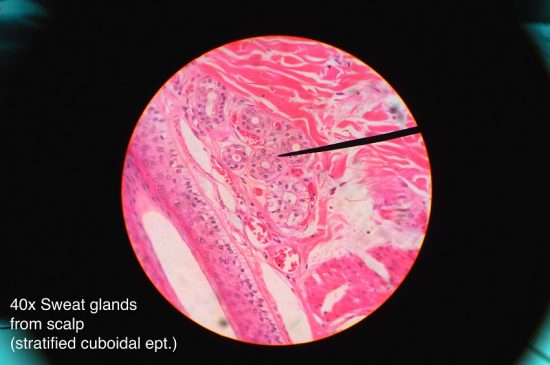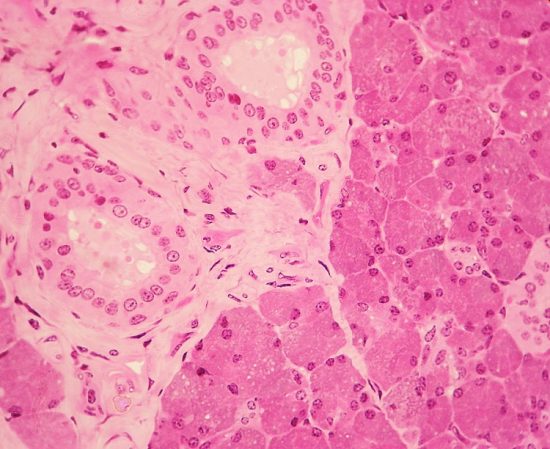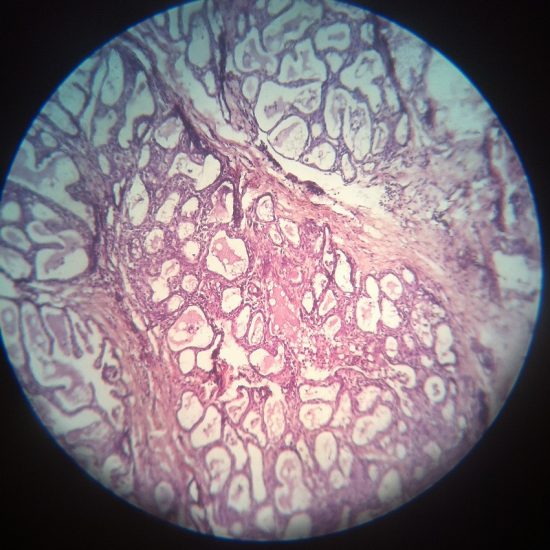Stratified Cuboidal Epithelium Definition
Stratified cuboidal epithelium is a type of epithelial tissue found mainly in glands, which specialize in selective absorption and secretion by the gland into blood or lymph vessels. In general, epithelial tissue is any group of cells lining a body cavity or body surface. Stratified cuboidal epithelium describes an epithelial tissue with two aspects. Cuboidal refers to the shape of the cells at the surface of the epithelium. Stratified refers to how the epithelial tissue has layers. The layers of squamous epithelial cells beneath the cuboidal cells replace damaged cells as needed to maintain the epithelial lining.
Stratified cuboidal epithelium allows glands and organs to create a separation between the functioning cells of organ or gland and the vessels that feed it. Stratified cuboidal epithelium is in many different tissues, as seen in the examples below. However it always has the same basic structure and function, with a few variations between organs depending on their exact function.
Structure of Stratified Cuboidal Epithelium
Stratified cuboidal epithelium consists of cube shaped cells bound together by various membrane junctions, or places between cells bound together with specialized proteins. For instance, desmosomes are a type of junction utilizing interlocking integral membrane proteins. The proteins from two cells lock together, much like microscopic Velcro. A tight junction is a form of “seal” between two cells, in which their cell membranes bulge out and touch each other. The seal will not allow fluids between the cells. The final connection, a gap junction, holds the cells together and also connects the cytoplasm of each cell. This allows cells to share nutrients and resources, while also strengthening the seal between the cells.
Stratified cuboidal epithelium has several layers, not all of which are cubes. These layers can be squamous or columnar as well. The basal layers of the epithelial tissue give rise to new cuboidal cells, which take their place at the surface of the epithelium as needed.
Function of Stratified Cuboidal Epithelium
Wherever it is found, stratified cuboidal epithelium serves two general purposes: secretion and protection. Stratified cuboidal epithelium typically makes multiple membrane junctions between adjacent cells. In effect, this creates an impermeable barrier between two distinct surfaces in the body. This barrier acts like a filter, forcing nutrients and water to pass through the cells. The cells themselves can then act as “gatekeepers” to the vessel, only allowing the appropriate substances through.
That is why stratified cuboidal epithelium is usually found in places like the sweat glands, which separate the body from the outside. Or, they could be found in the endocrine system, distributing necessary substances through small vessels in the body. As seen in the examples below, stratified cuboidal epithelium has many functions throughout the body.
Examples of Stratified Cuboidal Epithelium
Sweat Glands

The image above shows a sweat gland. At the tip of the black arrow is stratified cuboidal epithelium. The arrow itself points to a cluster of cube-shaped cells, clearly circling empty space. This empty space is a small vessel which leads out of the skin. When you sweat, this layer of stratified cuboidal epithelium allows various salt ions and water to slip into the vessel. When exposed to air on the skin, it evaporates. This cools the skin significantly.
Parotid Glands

Like the sweat gland, the parotid gland is responsible for making and secreting a substance for the body. The parotid gland secretes saliva into the mouth, aiding in chewing and digestion. Seen above is a microscope image of parotid tissue. The lighter colored cells on the left side of the image represent the stratified cuboidal epithelium. Here you can clearly see the stratification of many squamous cells packed behind the cuboidal cells near the saliva ducts. The darker cells in the image are likely responsible for making many of the substances in saliva, from lubricant molecules to enzymes meant to start digesting the food as quickly as possible.
Mammary Glands

Above is an image of a mammary gland, under the microscope. Though this image is zoomed further out than the others, you can still see the cuboidal cells surrounding the ducts. The dark ring around each duct is made of cuboidal cells, while the tissue between each ring is made of flatter, squamous cells. The many ducts present in this image is probably where the ducts are converging. Ducts flow from all over the breast to deliver milk to the nipple, which can then deliver a substantial amount of milk to a nursing offspring. The stratified cuboidal epithelium helps secrete the milk, while protecting the tissues of the breast from invasion by bacteria and toxin molecules.
Quiz
1. Which of the following correctly describes the FUNCTION of stratified cuboidal epithelium?
A. To protect internal cells and secrete substances
B. To protect the insides
C. To create substances for secretion
2. Select the answer which is MOST correct.
A. Epithelial cells are mostly found outside of the body.
B. Epithelial cells separate various spaces and protect cells.
C. Epithelial cells are the most important tissue.
3. Which of the following is NOT a type of epithelial cell?
A. Cuboidal
B. Squamous
C. Colonial
References
- Feldhamer, G. A., Drickamer, L. C., Vessey, S. H., Merritt, J. F., & Krajewski, C. (2007). Mammology: Adaptation, Diversity, Ecology (3rd ed.). Baltimore: The Johns Hopkins University Press.
- Lodish, H., Berk, A., Kaiser, C. A., Krieger, M., Scott, M. P., Bretscher, A., . . . Matsudaira, P. (2008). Molecular Cell Biology(6th ed.). New York: W.H. Freeman and Company.
- Widmaier, E. P., Raff, H., & Strang, K. T. (2008). Vander’s Human Physiology: The Mechanisms of Body Function (11th ed.). Boston: McGraw-Hill Higher Education.
